
This comparison test was well entrained when the somewhat inevitable news broke that General Motors was closing the Holden brand in Australia. Not that we have a Holden – per se – here, but rather a Holden Special Vehicle or HSV, which is half Holden, the other half being Walkinshaw Performance, tweaker of fast cars.
And while Holden may be closing in Australia, HSV will be staying through a proposed ongoing relationship with General Motors Specialty Vehicles. Whether that means the HSV SportsCat, which is based on the Thailand-made Holden Colorado will continue, is however up in the air as GM has also closed its Thai operations. That means the Colorado (and variants) will only be built at GM’s North American and Brazilian plants, which currently only produce left-hand drive models.
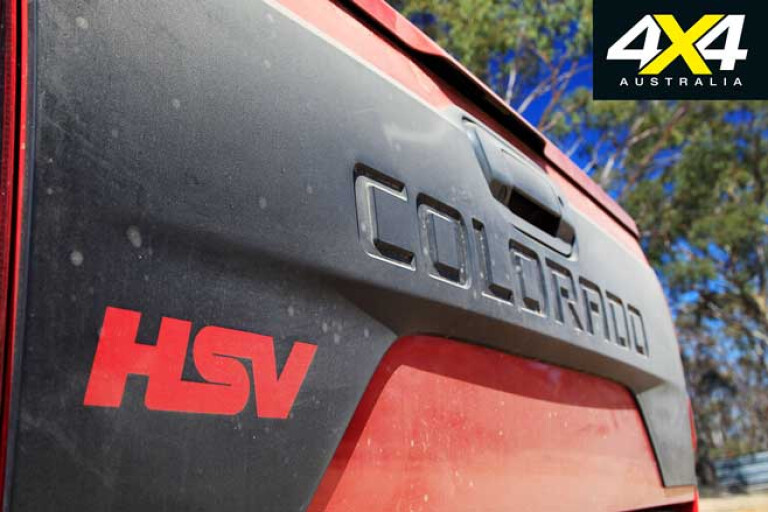
Still that may make it just the right time to buy a HSV SportsCat, given its potential collector’s item status as much, much more than a lifted, stickered and re-booted Colorado, but something that’s worthy of the HSV badge.
There’s an irony here too in that the SportsCat’s adversary, the Nissan Navara N-Trek Warrior, has been created by Premcar, which in an earlier life was Tickford Vehicle Engineering, the company behind Ford Performance Vehicles, the long-time adversary of HSV.
So here is in part a showdown of local engineering nous with a Holden verses Ford flavour primarily aimed at making a tougher and more off-road capable ute than the standard offering.
HSV Colorado SportsCat SV
In creating the SportsCat, HSV has done so much more than meets the eye...

HSV made its name off the back of Commodore V8s but with the demise of the locally built Commodore in late 2017 it turned its expertise to the Colorado and came up with the SportsCat. Given the Colorado was, and still is, Holden’s best-selling vehicle, and Australia’s broader love affair with dual-cab utes, it was the obvious thing to do…
Now you might think that the HSV makeover would mean more engine power but that’s not the case. HSV has looked to bring more ‘performance’ via a better chassis where the changes run far deeper than just a new tyre/wheel package and a lift kit.
Powertrain and Performance
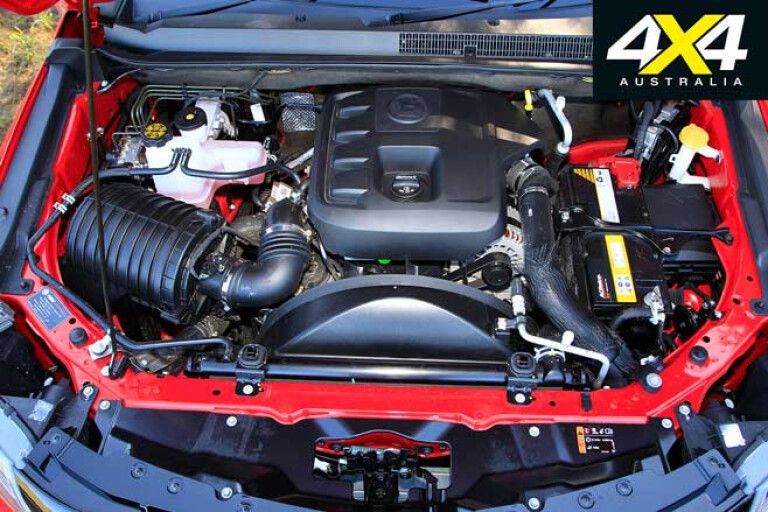
Both SportsCat models, the more expensive ‘SV’ we have here and the ‘V’, come with a standard Colorado powertrain, a VM Motori-sourced but GM-massaged 2.8-litre four-cylinder diesel backed by a GM six-speed automatic. This powertrain first appeared in 2012 in the then new-generation Colorado but was heavily and very successfully revised for the 2017 model year. Buyers also have the option of a six-speed manual.
This engine lives up its healthy claim of 147kW backed by its solid 500Nm of torque and gets on with the job nicely, all helped by a very proactive and sporty automatic gearbox. The taller overall gearing brought about by the SportsCat’s bigger tyres and the marginal increase in aero drag from what is a wider and taller vehicle knocks a little off the performance compared to a stock Colorado but it still feels relaxed and effortless in general driving – a little more so than the Warrior – and eager enough when asked to give its all.
With its midlife MY17 revamp, the Colorado’s powertrain became smoother and quieter than before but it’s still not the last word in refinement, but niether is the engine in the Warrior, so no real winner here on this count. Points however for the SportsCat’s gearbox, which seems to always pick the right gear at the right time, something that the seven-speeder in the Warrior doesn’t do as well.
On Road Ride and Handling
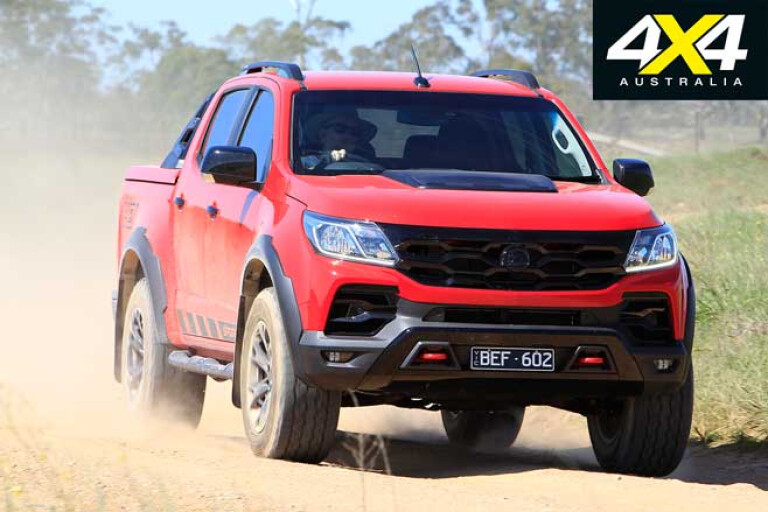
While the obvious changes – the taller and wider AT tyres and 45mm ride-height increase at the front – are aimed at improving the SportsCat off road, less obvious are the changes that make the SportsCat better on road.
These run deep and start with bracing the top mounts for the front springs and dampers. The standard pressed-steel top mounts for the front ‘struts’ are welded to the chassis rails behind the struts but are effectively open at the front.
What HSV has done is brace the front of the strut top-mount back to the chassis via a steel tube looped up and around the strut, which helps eliminate flex in this critical area and thus achieve better suspension control especially given the increased loads induced by the 30mm wider track (via wheel offset), and firmer front springs (110N/mm) and specially tuned and firmer MTV dampers.
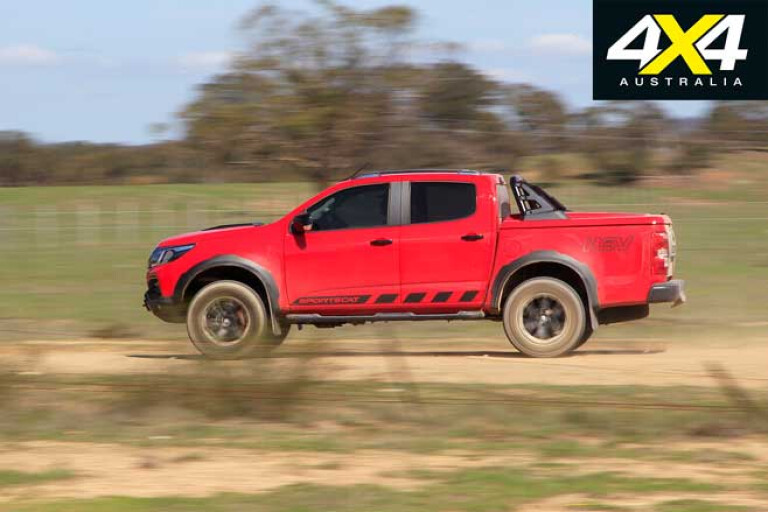
The SV model we have here also gains a real anti-roll bar that cleverly ‘decouples’ automatically when you engage low range. HSV engineers have also retuned the Electronic Stability Control to suit the heavily revised chassis.
The end result of all this is, and despite the extra ride height, the SportsCat is more dynamically engaging on-road, and the faster you drive it the better it feels. The ride is firm, even a little firmer than the already firm Warrior, but the control and confidence, especially compared to a standard Colorado is excellent.
Excellent feel too from the SportsCat’s electric power steering, which is sharper than the Warrior’s and with the extra benefit of very light low-speed manoeuvring.
Last but certainly not least, the SV SportsCat also gets competition-quality AP Racing four-piston front brake callipers and big 362mm x 32mm front brake rotors, which provide braking power and feel far superior to that of the Warrior.
Off Road
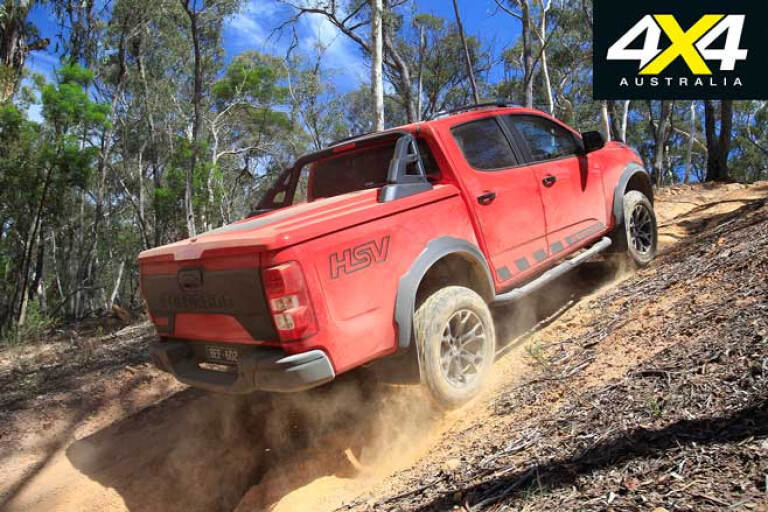
The SportsCat runs on 285/60R18 Cooper Zeon LTZs, which not only provide a more aggressive tread pattern than the standard Colorado 265/60R18 road-pattern tyres but add around 20mm in ride height all round. In addition the new springs provide another 25mm in lift at the front, which gives the SportsCat a more neutral stance than the nose-down look of a standard Colorado.
Compared to the Warrior, the SportsCat’s significant off-road advantage is that it offers more wheel travel and a more compliant ride off road. The extra wheel travel also means the electronic traction control (ETC) doesn’t need to work as hard on broken and uneven ground, but is effective when it does.
Part of the Colorado’s 2017 upgrade, which flows onto the SportsCat, is second-generation ETC with a specific off-road program that activates when low-range is engaged. As mentioned, the SV’s rear anti-roll bar also automatically decouples when low-range is engaged, so therefore doesn’t restrict the wheel travel as it would if it remained ‘attached’.
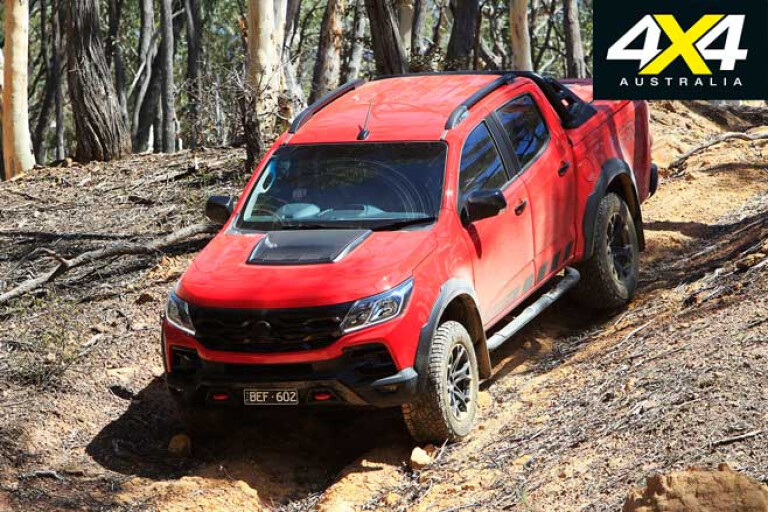
What the SportsCat doesn’t have compared to the Warrior is a driver-activated rear locker, but with the extra wheel travel and more effective ETC, it does well without it.
Not so good are the two front recovery hooks. They look tough but due to their shape and the surrounding bumper mouldings don’t easily accept shackles. As with the Warrior, there’s also no recovery hook at the rear.
Cabin, Accommodation and Safety
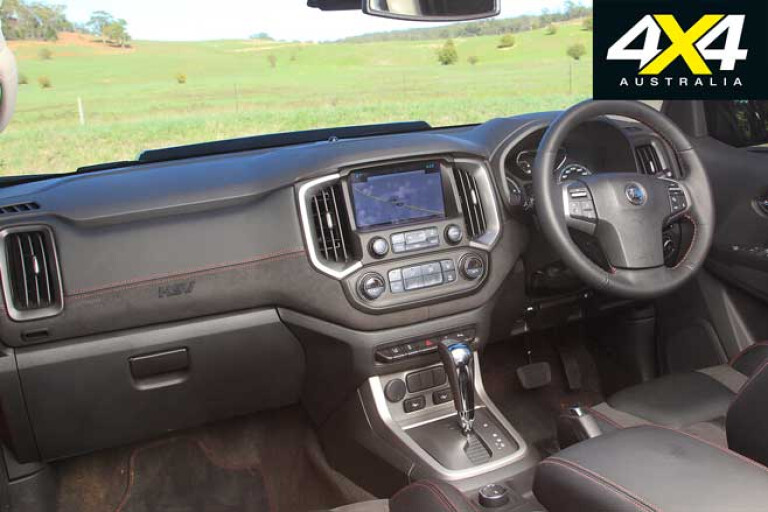
Climb aboard the revamped SportsCat and you’re greeted by a bespoke interior that includes new leather and suede trimmed seats, a new and thicker leather-trimmed steering wheel and new HSV branding on the headrests, instrument panel and floor mats.
The sports-style front seats are heated, comfortable and supportive, but there’s no steering wheel reach adjustment for the driver. The cabin feels notably bigger than the Warrior and while that doesn’t make much difference up front, rear-seat passengers will certainly appreciate the difference. Safety-wise the SportsCat offers a five-star ANCAP rating and a good dose of safety kit (see What You Get) even if it falls short of automatic emergency braking.
What You Get
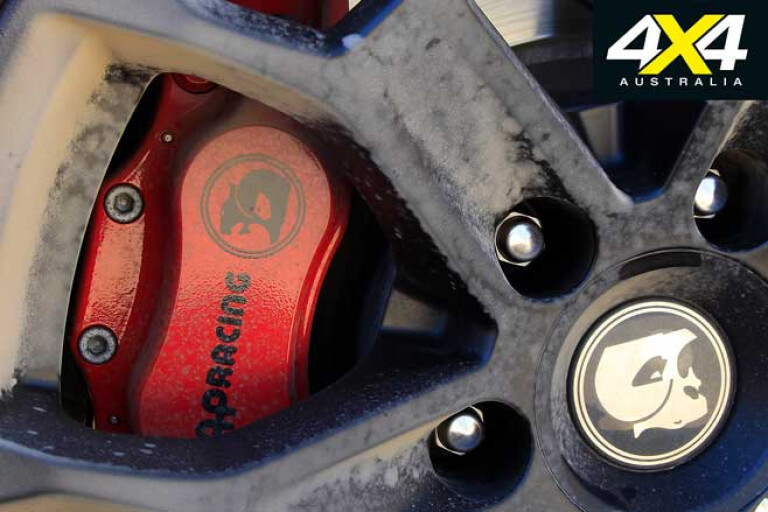
The SportsCat comes with either a six-speed manual or a six-speed automatic in both spec levels. Standard equipment includes leather/suede trim, heated front sports seats (with electric adjust for the driver), satnav, auto headlights and wipers, Apple CarPlay/Android Auto and a rear-view camera. Safety kit runs to seven airbags, tyre pressure monitoring, lane-departure warning and forward-collision alert.
The SportsCat V starts at $62,490 for the manual. The 6-speed auto adds $2200 while an additional $4300 will get you into the SportsCat SV, which brings the ‘racing-spec front brakes and the rear, auto-decoupling swaybar. Optional (+$2900) on both models are SupaShock remote-reservoir dampers while the SV ‘adds’ can also be optioned on the V.
Practicalities

If you’re looking to do a bit of ute-type work then the SportsCat offers more than the Warrior in terms of tub size, payload, GVM and GCM. Put simply, the SportsCat is bigger and beefier. Both still offer a 3500kg tow rating but if the tow-performance of the standard donor vehicles is anything to go by we would put our money on the SportsCat for heavy towing.
Both SportsCat models come with a hard tonneau complete with a very handy quick release system for easy removal, although this requires at least two people. A load-restraint system and tub liner are offered as options.
On test the SportsCat proved a little thirstier than the Warrior, and has four-litre smaller tank, so suffers a little in terms of touring range.
Nissan Navara N-Trek Warrior
Thanks to some local but factory-certified engineering the N-Trek Warrior is the Navara we have always wanted.

Nissan’s D23 Navara has never quite been what the doctor ordered sales-wise compared to the front-running Ford Ranger and Toyota Hilux. In fact in the 4x4 ute sales race it has also trailed behind Mitsubishi’s Triton, Holden’s Colorado and, more recently, the Isuzu D-Max. By contrast, the D23’s predecessor, the D40 Navara, was second only in sales to the then all-conquering Hilux.
To help address this, and hopefully get more customers in to its showrooms, Nissan Australia has joined up with Premcar, the current embodiment of Prodrive, Tickford and Ford Performance Vehicles. The brief was to make the D23 more off-road ready than the standard factory offering ... and to also look the part as a more serious 4x4 ute. The resulting N-Trek Warrior is still sold as a factory model with full factory backing and warranty thus allowing buyers an easy route to a ‘modified 4x4’.
Premcar’s work brings a bigger wheel/tyre package, specially tuned springs and dampers, a bespoke steel bullbar, underbody protection, an LED light bar, a redesigned towbar and various styling enhancements. As with the SportsCat the powertrain remains standard.
Powertrain and Performance
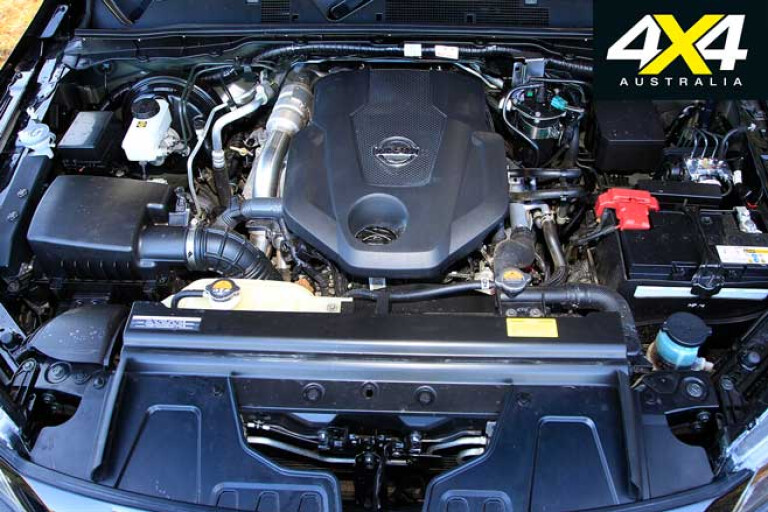
The Renault-sourced 2.3-litre bi-turbo four-cylinder diesel in the Warrior was originally designed for commercial use, in vans and the like, and is a little gruff and noisy under full load, but no more so than the 2.8-litre VM Motori-sourced diesel in the SportsCat.
Given the Warrior is some 200kg heavier than a standard Navara and the taller tyres raise the overall gearing a little over seven percent, the performance is dulled a little from a stock Navara, but still responsive enough. In standard trim the Navara’s overall gearing is relatively short so the taller tyres don’t really hurt too much as they would on something that’s already tall geared like a Hilux or D-Max.
In typical bi-turbo style the Warrior combines good off-idle response with its maximum torque (450Nm) on tap at just 1500rpm with a keenness to rev as the peak power (140kW) doesn’t arrive until 3750rpm. It’s still not quite as flexible at low revs as the 500Nm strong engine in the SportsCat but once in its stride it comfortably holds its own, and even starts to peg back the SportsCat at higher speeds, perhaps helped by the fact that the Warrior’s smaller body has less frontal area than the noticeably larger SportsCat.
For its part the seven-speed automatic shifts smoothly enough but doesn’t time its shifts as well as the gearbox in the SportsCat, tending to hang onto the taller gears longer under throttle load, and not back shifting – for stronger engine braking – on descents as readily.
On Road Ride and Handling

The Navara is unusual among the popular utes in as much as it has coil springs, in its case dual-rate coils, rather than leaf springs at the rear. With the Warrior, Premcar has still used dual-rate coils but they are softer in the initial spring (34 vs. 37N/mm) and firmer in the second spring (85 vs. 77N/mm).
Up front lighter 74N/mm springs replace the stock 79N/mm springs but there’s an extra long, progressive bump stop, which firms up the spring rate towards full compression. Robust Tenneco-brand dampers – tuned by Premcar’s engineers – replace the stock dampers although the standard swaybars are retained.
Premcar’s main aim with the Warrior was to improve the stock Navara’s off-road performance, but the retuned suspension also works wonders on road. And like any good suspension tune, the more demanding the conditions and the faster you drive, the better it feels. A 30mm wider track, achieved via wheel offset, also helps to provide a more stable package by countering the extra ride height.
The Warrior’s ride is firm at lower speeds, most likely due to stronger compression damping and despite the lighter initial springs, but softens up at highway speeds to provide not just control, but a level of compliance that a standard Navara can’t match.
Off Road
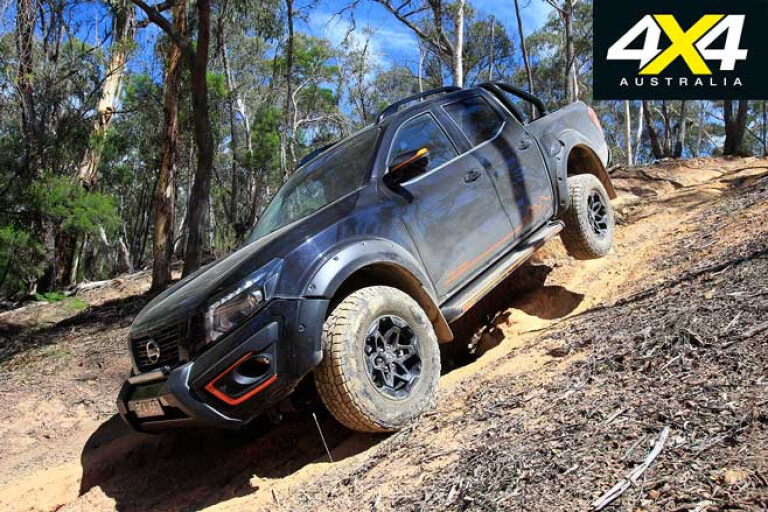
The Warrior’s taller and wider 275/70R17 wheel and tyre package, that replaces the standard 255/60R18s, brings 25mm more ride height while the new springs add another 15mm of lift. This extra 40mm of lift may not sound like much but given the stock Navara is one of the lowest slung of the mainstream utes, the extra lift is most welcome.
The new tyres – Cooper Discoverer AT3s – are a more robust ‘Light Truck’ tyre than the standard offerings and come with a more aggressive tread pattern, both also advantageous off road.
The Warrior has a conventional part-time 4x4 system but does offer a notably deep low-range reduction. Along with the short first gear the Warrior’s crawl ratio is better than that of the SportsCat but the gearbox itself doesn’t work as well in low range as the far more cooperative auto in the SportsCat.
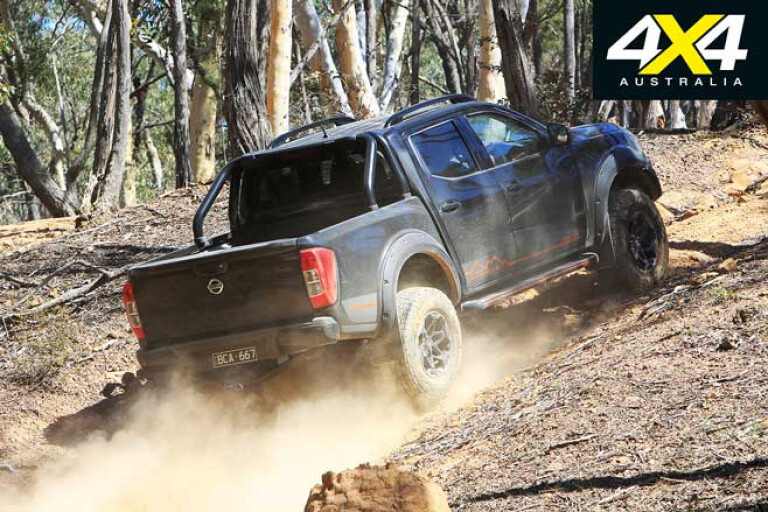
Perhaps more telling is the fact that the Warrior can’t match the wheel travel of the SportsCat, nor the SportsCat’s well-sorted electronic traction control. Still, all is not lost as the Warrior has a driver switched rear locker, which when engaged keeps the electronic traction control active on the front axle.
With the locker engaged the Warrior doesn’t give much or anything away to the SportsCat on washed-out climbs and the like but does give away some fording depth due to the location of its air intake under the bonnet lip.
Cabin, Accommodation and Safety

The Warrior is based on the top-spec ST-X Navara, which means plenty of kit (see ‘What You Get’) including smart key entry and push-button start, features missing on the SportsCat. The Warrior also gets its own themed interior, over and above the ST-X, with its bespoke part-leather seat trim and carpets.
The Warrior’s cabin is noticeably smaller than the SportsCat and while this doesn’t make much of a difference up front, three people will definitely feel the difference in the rear. As with the SportsCat, there’s no reach adjustment for the steering wheel, only tilt adjustment but the driving position is still comfortable enough although taller drivers might prefer the SportsCat given the extra room.
The Warrior hasn’t been ANCAP tested as such but a standard Navara achieved a five-star rating when last tested but doesn’t come with any notably high-end safety features.
What You Get
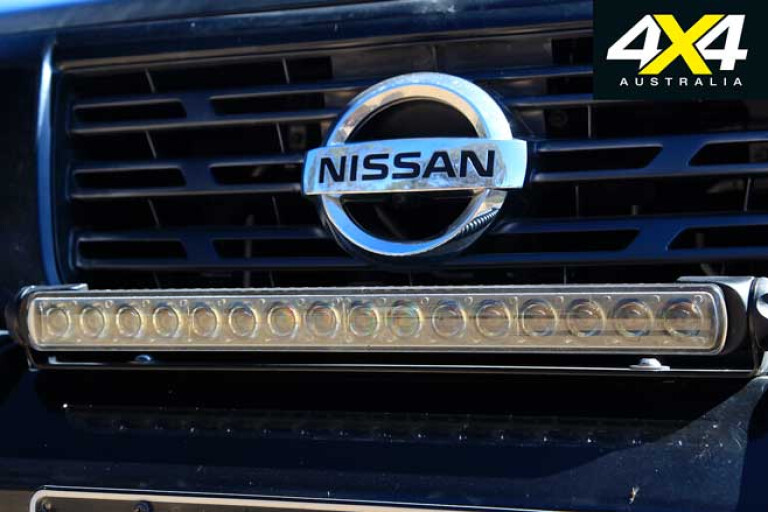
The Warrior’s safety equipment starts with front, side, curtain and driver’s-knee airbags and runs to the full suite of electronic chassis control systems, a reversing camera and a 360-degree view monitor.
Convenience and comfort features include smart-key entry, push-button start, bespoke leather seat trim, electric seat adjust for the driver and heated front seats, auto headlights, rear sliding window panel and dual-zone climate control. Embedded satnav, an eight-inch touchscreen and Apple CarPlay/Android Auto are also standard features. The rear tub has a twin-rail adjustable tie-down system and a 12-volt outlet.
Practicalities
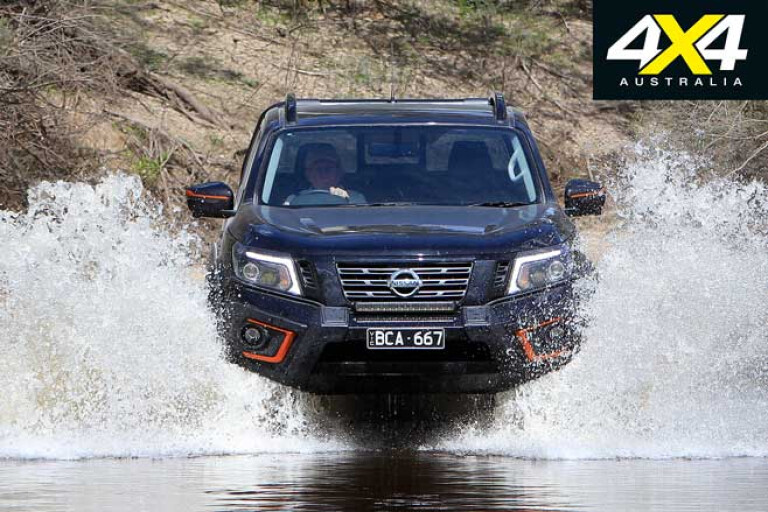
Heavy-duty towing has never been a Navara D23 forte and while Nissan’s two attempts to improve the Navara in that regard have been in-part successful, and the Warrior feels like it may do a better job again, chassis-wise, than a standard Navara at towing the claimed maximum of 3500kg, something around 3000kg is probably more around the mark.
Certainly for towing heavy loads, if that’s what you want, the SportsCat would seem like the better prospect given the respectable heavy-duty tow performance of a standard Colorado. Likewise, the Warrior has a smaller tub than the SportsCat and notably less claimed payload.
Verdict
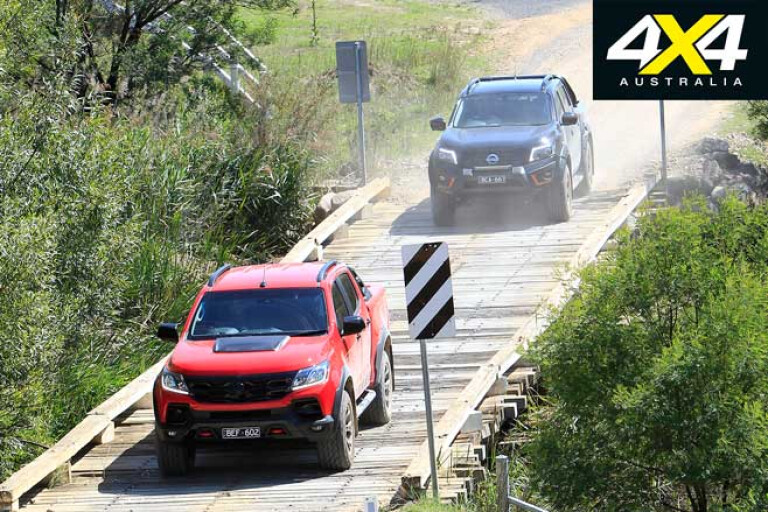
Both the HSV Colorado SportsCat and the Nissan Navara N-Trek Warrior achieve the remarkable. While both are primarily engineered to be more capable and useful off road, both also end up being far more dynamic on road than their respective donor vehicles. To do this, when both sit higher and ride on Light Truck rather than Passenger tyres, is testament to the quality of the suspension re-engineering both in terms of the components used and the expertise of the respective engineering teams. Bravo.
What separates these two utes is not however the quality of the chassis re-engineering but the core aspects of both vehicles that are unchanged in the respective transformations, most notably the powertrains and the cabins.
The fact that the SportsCat’s engine generally feels more muscular and is backed by a more in-tune gearbox applies as equally to this test as if a standard Colorado was lined up against a standard Navara. Likewise the fact that the SportsCat has a bigger cabin is also a quality inherited from its donor vehicle. The fact that the SportsCat is also a beefier workhorse also reflects the relativity of the two donor utes.
But in all things, there’s a price to be paid in all this. The Warrior is under $66K driveaway, while the SportsCat SV you see here is $69K plus on-road coats – call it $75K, depending on what state you live in. That’s the better part of $10K. Of course forgo the SV’s trick front brakes and auto-decoupling rear swaybar and save $4300 on the lower-spec V model, but then you also get a lesser vehicle. The choice is yours.
Specifications
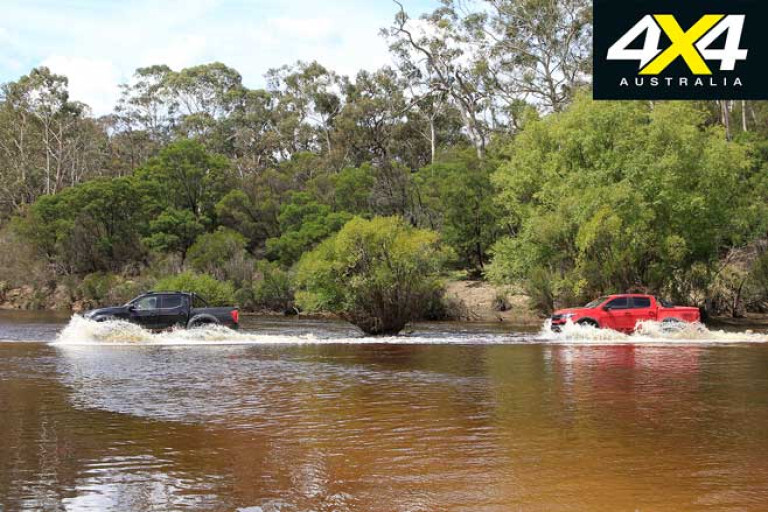
| Nissan Navara N-Trek Warrior | HSV Colorado SportsCat SV | |
| Engine | 2.3-litre 4-cyl bi-turbo-diesel | 2.8-litre 4-cyl turbo diesel |
| Power | 140kW @ 3750rpm | 147kW @ 3500rpm |
| Torque | 450Nm @ 1500-2500rpm | 500Nm @ 2000rpm |
| Gearbox | 7-speed automatic | 6-speed automatic |
| 4x4 System | Dual-range part-time | |
| Crawl Ratio | 44.4:1 | 36.4:1 |
| Construction | Separate-chassis | |
| Suspension (f) | Live-axle /coil springs | Independent/coil springs |
| Suspension (r) | Live-axle /coil springs | Live axle/leaf springs |
| Wheel/tyre spec | LT275/70R17 121/118 Q | LT285/60R18 120 S |
| Departure Angle | 19.0˚ | 24.0˚ |
| Rampover Angle | 27.5˚ | 27.0˚ |
| Approach Angle | 35.0˚ | 32.0˚ |
| Wading Depth | 500mm (approx.) | 600mm |
| Ground Clearance | 268mm | 251mm |
| Kerb Weight | 2186kg | 2250kg |
| GVM | 2910kg | 3150kg |
| Payload | 724kg | 900kg |
| Towing capacity | 3500kg | |
| GCM | 5910kg | 6300kg |
| Fuel capacity | 80 litres | 76 litres |
| ADR fuel claim | 7.0L/100km | 8.7L/100km |
| Test fuel use | 10.6L/100km | 12.0L/100km |
| Test fuel range | 755km (+50km) | 583km (+50km) |
| Price | $65,490 (driveaway) | $68,990 (plus ORC) |

COMMENTS